Maturity
In modern societies the art of literature is often seen as a refuge. In early 19th century that connection was not as self-evident mainly due to the censorship of all printed texts and especially books. Writers struggled for freedom, while literature was banned and censored based on somewhat trivial claims. When Napoleon’s ironclad control was lifted in 1815, French literature blossomed. Honoré de Balzac, Alexandre Dumas, Victor Hugo, Stendhal, were all writers who lived and worked in Paris in the 1820’s, writers who left an indelible mark in their art and described in the most graphic way how it was to be poor in early 19th century Paris. Their fame and worldwide appeal added to the long line of tradition passed on by the thousands of scholars of the Sorbonne during the years, by Moliere and Voltaire and followed a few years later by Flaubert (1821 -1880) and Zola (1840 – 1902) created a myth, an inexorable link between European writers and Paris that would continue well into the 20th century.

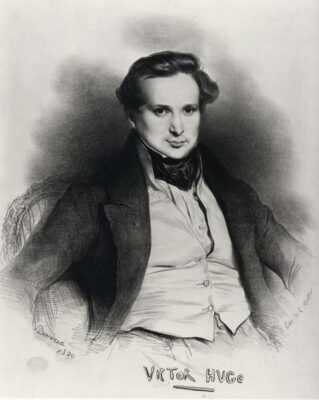

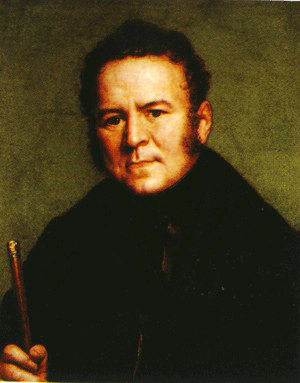
The classes laborieuses of Paris had no real interest in celebrating the coming of the new king Louis Philippe I. For the lower classes the pressing matters had not been resolved. Two epidemics of cholera, in 1832 and in 1849, hitting mostly the residents of poor slums, where the new waves of incoming population resided in horrid conditions, took the lives of nearly 40.000, mostly members of the under-class, a class so graphically portrayed in Victor Hugo’s novel of Les Misérables.
Despite his good intentions Louis Philippe I reigned in a time of profound social unrest. Between 1830 and 1848 there were 6 large riots and attempts to take control of the capital. The new socialist ideology gained momentum making Paris a magnet of revolutionaries from foreign countries like Karl Marx who moved in the French capital in 1843, Friedrich Engels (1844) and Mikhail Bakunin (1844). The industrial revolution went hand in hand with the awakening of the working class. The growing number of strikes and confrontations with the government came to a breaking point in the summer of 1847 after an abrupt disruption of the economic growth caused by a shortage of credit. When the government tried to impose a general ban of demonstrations with the help of the National Guard in February 1848, most guards ended up on the other side of the barricades. The crowds were once more invading the Tuileries Palace. The royal throne was seized, carried to Place de la Bastille, and burned. Louis Philippe was forced to flee Paris in disguise. The Second Republic was proclaimed at the Hôtel de Ville from the poet Alphonse de Lamartine appointed president of the provisional government.
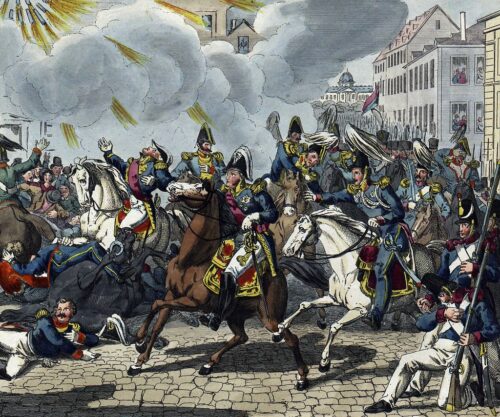

The first popular vote, through universal male suffrage in 1848 was not won by neither socialists nor leftists but by Louis-Napoléon Bonaparte, nephew and heir of Napoleon I. Once again the Parisian proletariat realized that starting a revolution did not guarantee that the ones who started it were actually the ones who were in power after it ended. The first president in the history of the French republic took residence in the Élysée Palace, a classical palace built in 1722 near the Champs-Élysées for a prominent nobleman and bought by Napoleon I in 1808.
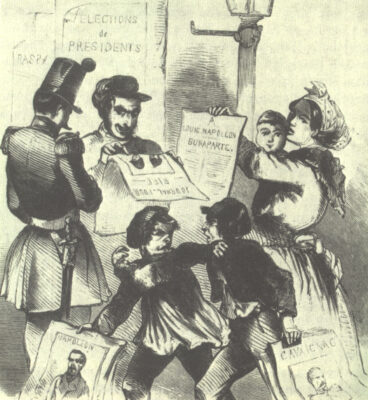
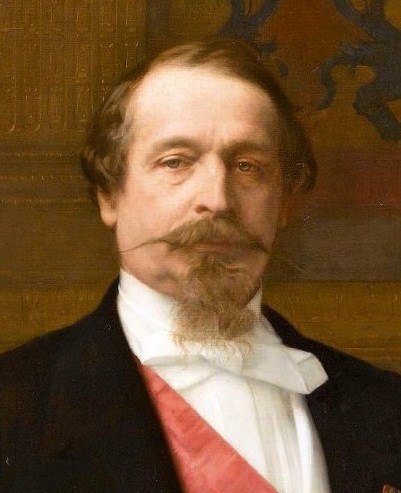
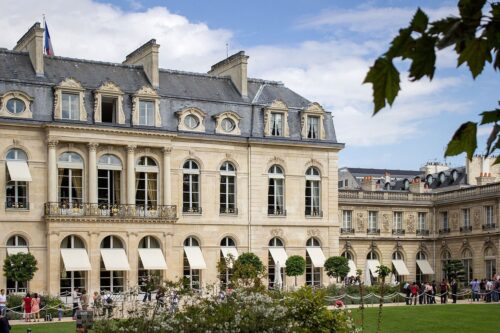
What followed in Paris was a reconstruction and modernization of such a grand scale that in the course of the thirty years that followed the whole structure of the capital would be transformed and ushered into the new age. A huge construction site with thousands of workers managed by the prefect Georges-Eugène Haussmann and supervised by Louis Napoleon was set in motion. The plan to raise Paris’s infrastructure to that of London, a city Louis Napoleon was very familiar with. To make the city more spacious, airy, free it from the narrow allies and the slums.
In 1851 Louis Napoleon’s term expired and his plan for the rebuilding of Paris was barely at the start. With the new constitution blocking his plan for re-election Louis Napoleon followed the example of his uncle. With the help of the army he staged a coup, he made himself emperor as Napoleon III and cleared the field of opponents and fervent republicans like Victor Hugo. All the obstacles that were till then forestalling the progress of his plans for Paris were thus sidelined. The French parliament and the new investment bank, Crédit Mobilier provided the needed funds and the workers got to work.
Starting from the water and sewer system that had plagued Paris from the very beginning, an underground labyrinth of new pipes, hundreds of kilometers of new pipes wide and large enough to carry huge amounts of waste and equal amounts of water were created under the sidewalks of old and new boulevards, solving the capital’s greatest problem. The same tunnels were used to provide gas for heat and for lights to illuminate Paris. Up on the ground a plan inspired by Napoleon for A grande croisée , a great cross of two main avenues that would permit easier communication from east to west along the Rue de Rivoli and Rue Saint-Antoine, and north-south communication along two new Boulevards, Strasbourg and Sébastopol was completed in a record time for the Paris Universal Exposition of 1855, as was the Grand Hôtel du Louvre, the first large luxury hotel in the city built to house the Imperial guests of the Exposition.
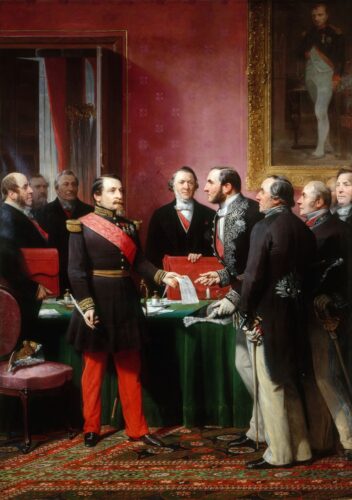


In order for the new avenues and parks to be built there was extended demolition of old medieval neighborhoods that were seen as an impeding relic of the past. Thousands of trees were planted along the new avenues, their junction became the site of new squares, fountains and parks, their finishing adorned with beautiful monuments. The appearance of the new city was of the utmost importance so every building had to abide to strict rules of uniformity. The Île de la Cité was almost completely torn down, its bridges rebuilt, the old landmarks like Notre Dame and Saint Chapelle were renovated and new government buildings like the Tribunal de Commerce were built in the opulent eclectic style of the era, a mixture of neo-renaissance and classical. Two new railway stations the Gare de l’Est (1849) the Gare de Lyon (1855), the rebuilding of Gare du Nord (1865), of the market of Les Halles and the hospital Hôtel-Dieu, the expansion and renovation of the Louvre, the restoration of dozens of old churches and the building of several new like Saint Augustine church, of theaters like the Châtelet and Théâtre Lyrique of the Opera Palais Garnier, of landmark squares like the Place du Trocadéro, of Parks like the Jardin des Tuileries and the Jardin du Luxembourg, even park gates, garden fences, kiosks and public toilets, became all part of one of the largest beautification projects in the history of European cities. Long after Napoleon III was gone his plan was still carried through changing for ever the face of the capital and the living conditions of the Parisians. A great example of the architectural unity bequeathed to Paris by Napoleon III are the Haussmann apartment buildings which line the boulevards of Paris, all built by the same materials, all seen as a unified structure.
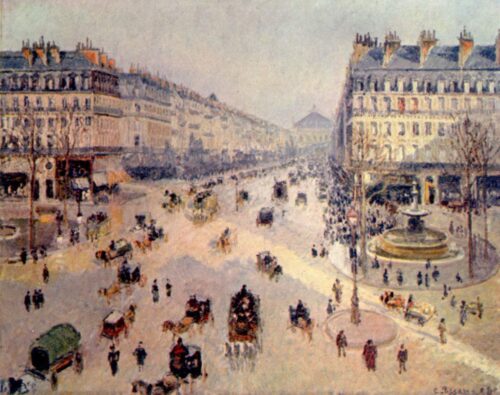
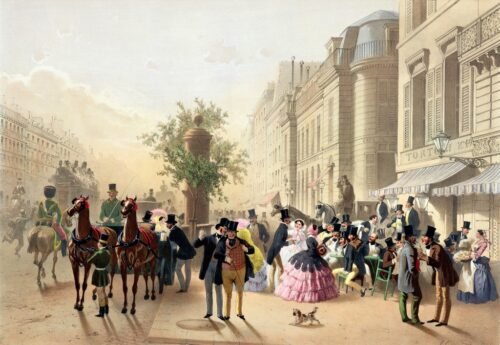
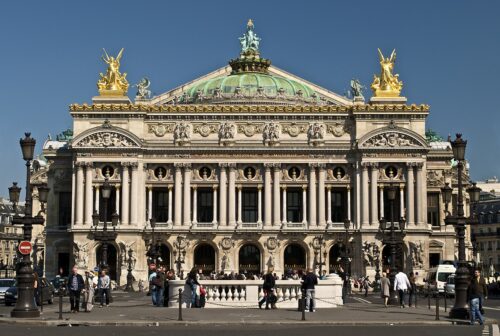
By 1870 Paris was again a city of light, illuminated by thousands of gas lights. Their effect was multiplied by their reflection on the local cream-colored Lutetian limestone by which almost all the buildings from the Haussmann period were constructed. The countless cafes and restaurants of the capital made the most of the new reality. More prosperous Parisians were mostly frequent of the western neighborhoods, where the air was always cleaner and the open spaces more. Toward the east and the outer neighborhoods where rents were lower, one could find mostly lower-income tenants. The two classes converged at the wide promenades where rich and poor, men, women and children strolled in the afternoons with their high hats (men) and bell-shaped dresses (women).
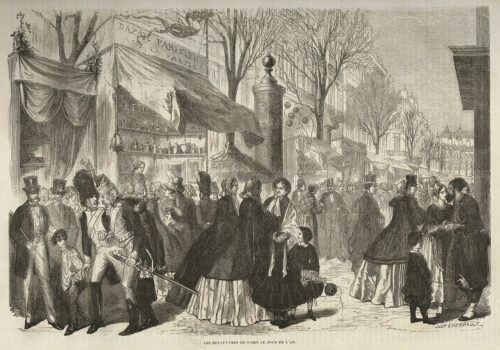
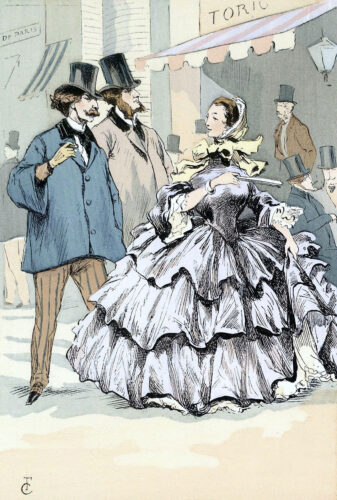

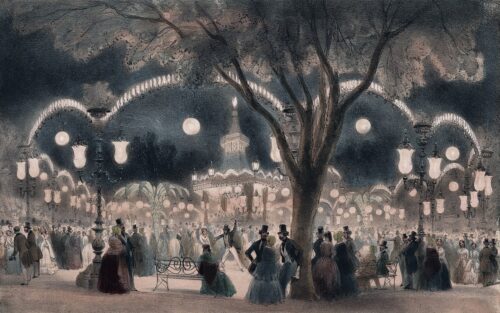
Napoleon III’s frenzied push for a reshape of the map of Paris resembled the one of his uncle for a change in the European map but the similarities between the two ended just about there. In the military field the two were not so much alike. In 1870 France entered a war with the rising military Prussia of Otto von Bismarck. Despite the enthusiastic war cries that resounded through the streets of Paris when the news reached the people “to Berlin!!”, the war very soon proved to be a disaster for France. In a matter of days Bismarks’ s army was outside the gates of Paris. On March 1, 1871, Prussian, Bavarian and Saxon troops held a brief victory parade in Paris after a successful siege that had lasted four months. Napoleon III left France and for a brief period of time, Paris was ruled by the radical socialists who tried to hold on to power but were defeated by the army of the Third French Republic in the battles that took place across the streets of the capital. The Tuileries Palace, the Hotel de Ville and the Richelieu library of the Louvre were among the buildings that payed the price of their frustration for the defeat.
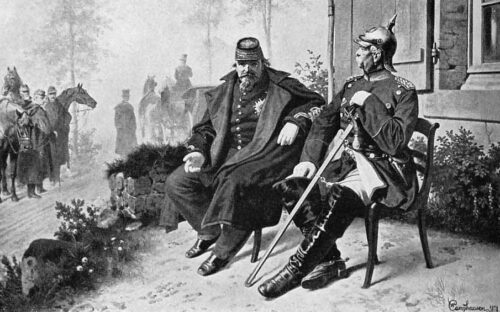
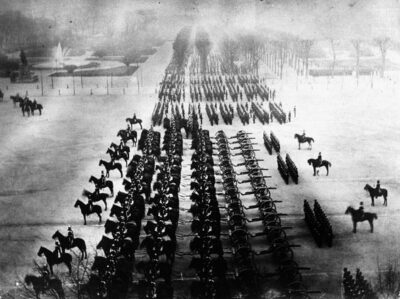
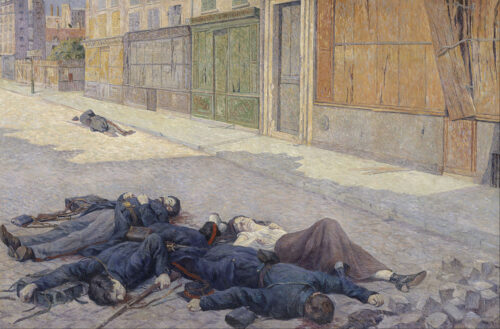
The period of the third republic between 1870 and 1914 is also known as the Belle Époque (beautiful era). The finishing touches of what most people identify as the city of Paris today, were actually unfolded during that 44 year era. The most outstanding symbol being of course the Eiffel tower, the wrought iron, 324 meters tower, built for the international fair of 1889. The tallest man made structure in the world at the time was not met with a unanimous appreciation. Quite the opposite. There was even a committee against its construction made up by writers, painters, sculptors and architects who argued that the tower would mar the image of the capital. They would surely be devastated to learn a few years later that the city would not dismantle it after the passing of twenty years according to the initial permit. Most Parisians were not so negative however. They saw the new tower as a sign of a brave new world, one that would be dominated by science and technology. The signs of progress could be seen everywhere and new machines were being placed in the service of man by the day. Some of those symbols of progress were the installation of the telephone system, the illumination of the Grand Boulevards by electric lights, the construction of Paris Metro and the increasing number of automobiles roaming the streets of the capital.
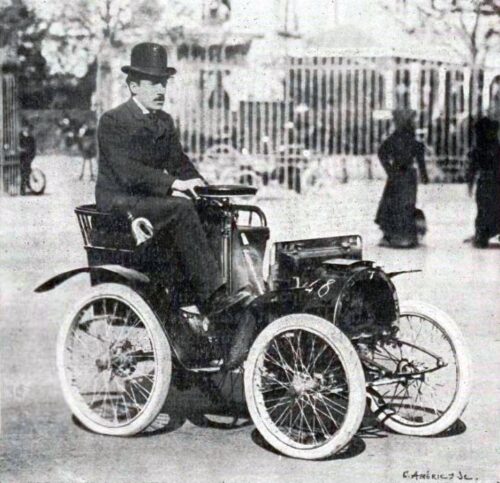
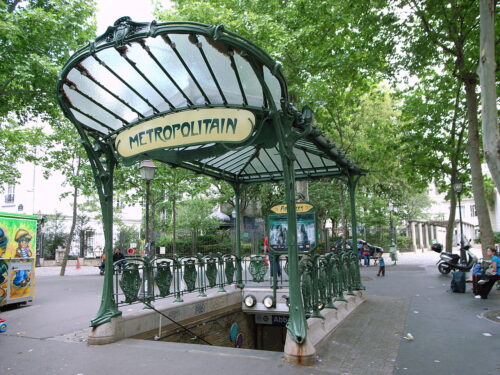
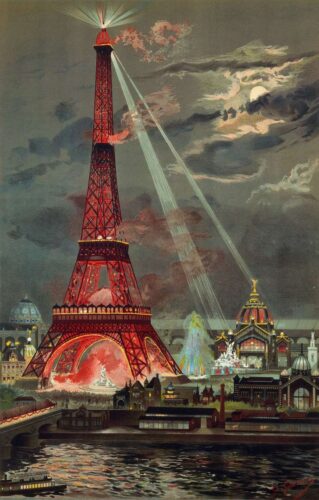
In architecture there were three notable additions to the cityscape. The first was the Galerie de Zoologie today the Grande Galerie de l’Evolution. The second was Pont Alexandre III that connected the Champs-Élysées quarter with the Eiffel Tower. The third was the Grand Palais, a sumptuous exhibition palace built on the right edge of Pont Alexandre at the Champs-Élysées side for the Exposition Universelle of 1900. All three are characteristic specimens of the Beaux-Arts style, an elegant mixture of French neoclassicism Gothic and Renaissance that developed in Paris in the end of the 19th century and spread later to the rest of the world.
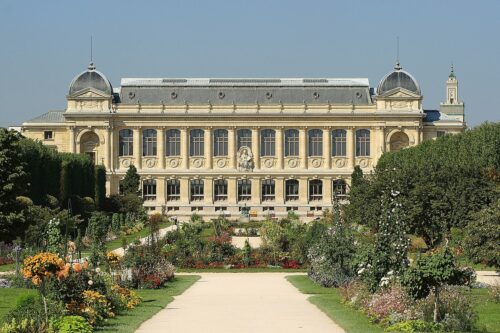


In art Paris was taken over by the Impressionists, a group of talented artists like Claude Monet and Pierre-Auguste Renoir who defied the traditional norm of French painting and ventured a new approach in both themes and methods. Their vibrant colors, their novel depiction of light and shade and portrayal of every day life became a movement followed by new talents like Edgar Degas, Camille Pissarro, and Paul Cezanne and would be identified as the most distinctive expression of the optimism of the Belle Époque. It wasn’t just the Impressionists who were painting their way to fame though. In the first years of the 20th century Henri Matisse, Amedeo Modigliani and and Pablo Picasso were making history from their ateliers in Montmartre. Their works, often inspired by the bohemian and artistic atmosphere of Paris at the time would define modern art to this day.
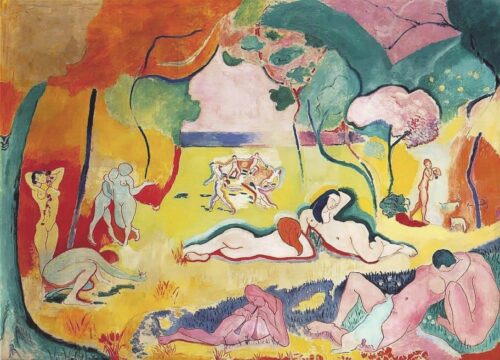


In August 1914 Paris found itself entangled in a new war against the Germans. This war although welcomed by many Parisians who longed for a revanche after the losses of the Franco-Prussian war of 1871, would for ever end the halcyon days of the Belle Époque. It would however find them against their deep rooted anti-British sentiments in a cordial alliance with their yearlong enemy, the English. With most men being drafted and the rest partaking in patriotic demonstrations around Paris, there was no room during the first hours of war for pacifists. When the Germans started marching towards Paris, the trainloads of refugees from Belgium started coming in and the first German planes appeared over the city, the situation changed somewhat. The city started preparing for a long siege, the defensive forts around its perimeter were manned with soldiers and equipped with machine guns and cannons while the government left Paris for Bordeaux.
At a breakneck speed the German advance reached the eastern outskirts of Paris by September of 1914. The German plan for a swift and mighty blow that would bring France to its knees seemed to work out perfectly and the art treasures of the Louvre were already crated up when a miracle, the Miracle of the Marne happened. French intelligence uncovered the plans of the German offensive and Paris was saved. In one of the most crucial and bloodiest battles in European history, six French armies and the British Expeditionary Force managed to stop the German advance and in essence win the war. It would take four long years in the trenches and millions of dead, for Germany and Austria to accept their stalemate.
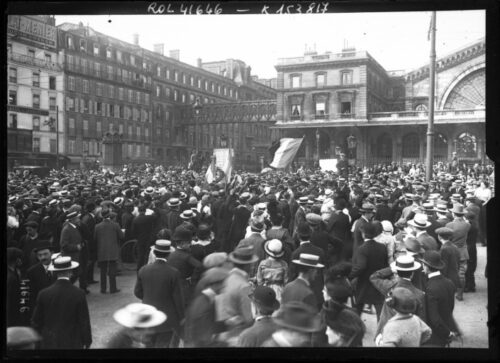
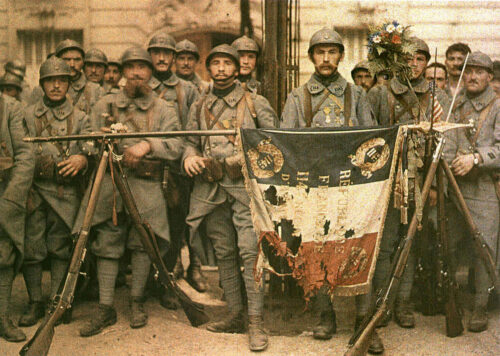
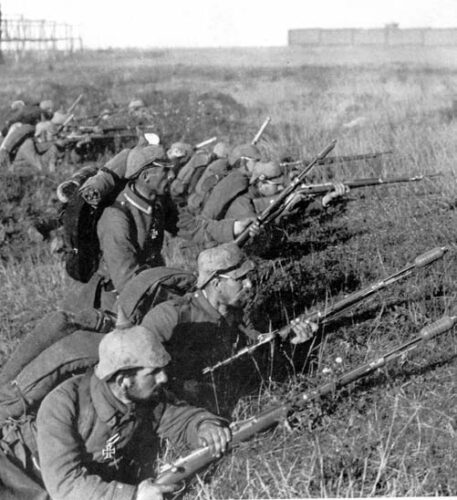
The war changed Paris as it changed the whole world. The difference with the rest of the world was that Paris was too close to the front to ignore the horrors of it. The lightheartedness of the Belle Epoque seemed a far distant memory. After the celebrations for the victorious end of the war died down, the harsh reality of the food shortages and rationing continued. Widows, orphans and handicapped veterans measured in the tens of thousands and the deadly epidemic of the Spanish flu was still taking lives. The city struggled to find its pace. The sorry state of the economy deteriorated further when Germany defaulted on its payments and expected reparations were never met. The communists of Paris dreamt of a Russian style revolution of the proletariat, inflation and unemployment made their arguments stronger. The composition of the elected representatives did not reflect their beliefs though. Two-thirds of the seats of the National Assembly of Paris were won by the conservative republicans in the elections of 1919. That changed in the elections of 1924 when a left coalition triumphed and the strongest opposition party became the communists. The labor unions increased their pressures with massive strikes and the eight hours work day became a law of the state.
The sociopolitical hodgepodge of the 20’s was in reality one of the most interesting in the city’s history despite the post-war solemnity and the decrepit economy. This was the era when the radio and the movies became part of everyday life, the era of jazz-craze, of swing music, Charleston and cabaret, of the first department stores and high fashion. Coco Chanel opened her first boutique in Paris in 1921 and started selling her legendary Chanel No5 fragrance. It was also the era when painters like Pablo Picasso, Salvador Dali and Joan Miró, musicians like Igor Stravinsky and writers like Marcel Proust, George Orwell, Ernest Hemingway, Jean Cocteau, James Joyce lived and worked in Paris. Very frequently these intellectuals, the crème de la crème of intellectuals, would meet at the salon of the American writer and art collector Gertrude Stein. According to F. Scott Fitzgerald who also made frequent visits to Paris in the 20’s “The best of America drifts to Paris. The American in Paris is the best American. It is more fun for an intelligent person to live in an intelligent country. France has the only two things toward which we drift as we grow older – intelligence and good manners. “ According to Ernest Hemingway “If you are lucky enough to have lived in Paris as a young man, then wherever you go for the rest of your life it stays with you, for Paris is a movable feast”.
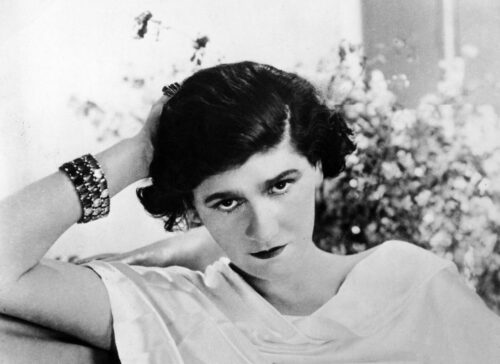
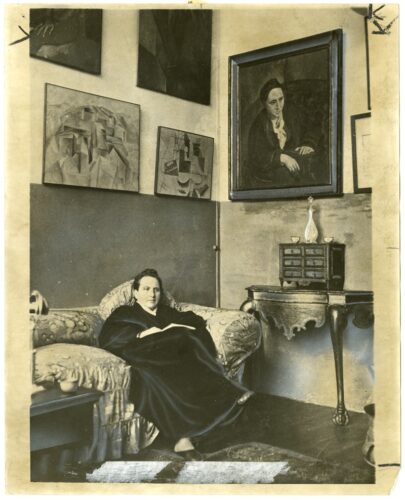
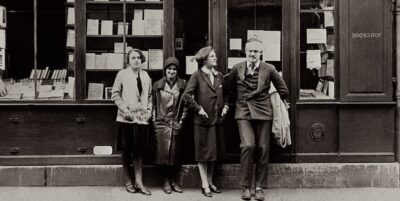
The Années folles or crazy years of the 1920′ s came to an official end with the coming of the Great Depression in 1931. Suddenly the party was over. Music kept producing talents like Django Reinhardt and Edith Piaf both of whom were discovered by the Parisians in the 30’s, night clubs kept working but some of the most iconic like the Moulin Rouge that targeted the high society fell out of fashion. The economy suffered a blow, not as strong as in US and Germany but still the galloping GDP of the 20’s hit the breaks and unemployment started rising. For most Parisians like Simone de Beauvoir all these were but a dent in an otherwise golden age when peace seemed to be indisputable for everyone in France and even the rise of Hitler in Germany in 1933 nothing but the inner workings of German politics. It was crazy to think that a new war was on the way. What was alarming for most Parisians was their own politics and the disturbing lack of continuity in their own affairs. After almost a decade of short-lived and inefficient governments, of tense confrontations between left and right and a general contempt for politicians of both ends of the spectrum, France found itself completely unprepared in the face of WW2. Not willing to accept the possibility of another war the country had buried her head in the sand, failing to read Hitler’s signs. On 22 August 1939, the Nazi-Soviet pact was signed and ten days later Hitler invaded Poland. Britain and France declared war on Germany shortly after that.
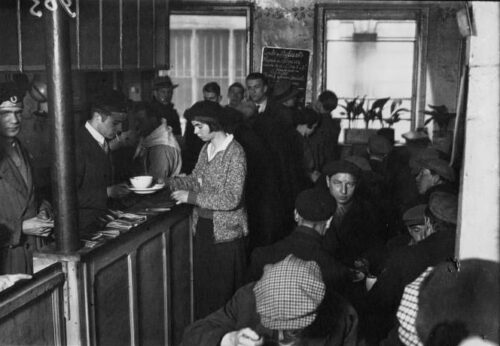
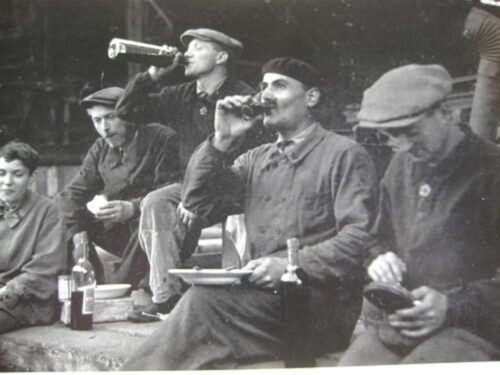
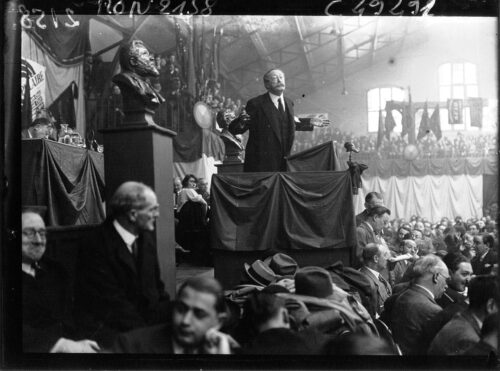
Hitler wanted Paris to be the second city of his Thousand Year Reich and expressed his conviction that its new masters would manage to preserve “this wonder of Western civilization” for posterity. During the first days of the occupation the fact that the buildings of the capital stood as proud as ever made no difference to Parisians. Nearly three quarters of the population had fled the city and the rest remained locked up inside their houses. The city looked completely deserted. The initial shock didn’t take long to be assimilated and life came back us swiftly as it had departed, restaurants and cafes started working adjusted according to the new clientele which under strict orders behaved impeccably. The situation of course was anything but normal. The loudspeakers warning of death punishment against any hostility that would target the occupation troops, the strict curfew hours and the first winter rationing that made life a constant hunt for food and fuel were anything but normal. Books were censored, radio and newspapers became an instrument of German propaganda, works of art that were deemed improper were burned in the Louvre courtyard while those considered of high value were conveyed to Germany. Tourists and Americans had long gone so the hotels were used by the German soldiers. German signs leading to the various German headquarters were everywhere, the statues and monuments of WWI were destroyed.
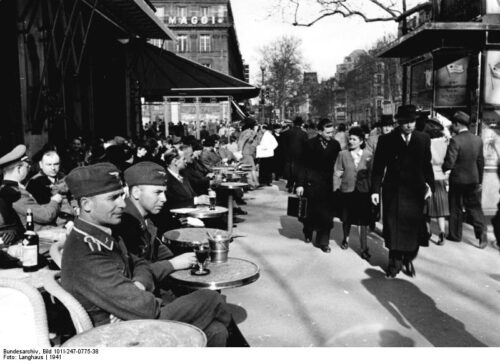
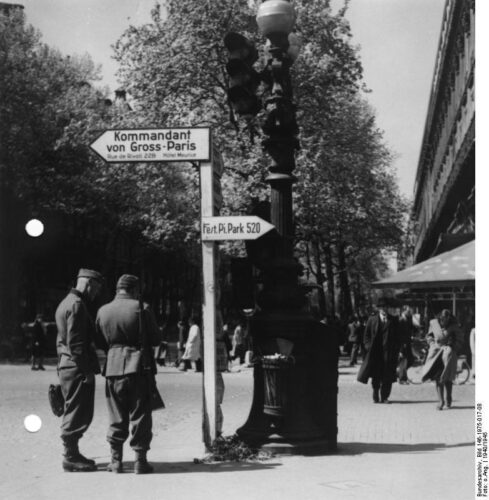
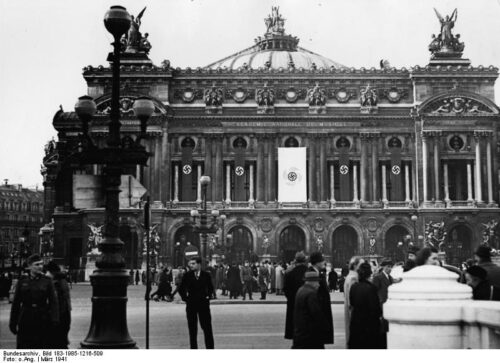
Agricultural products and fish that were staple foods until the first winter of the war were first funneled to the Wehrmacht or sent to Germany, what was left was split among frustrated and hungry Parisian citizens who had to stand in long lines. The rest of the products were bought with coupons that were allotted by a long line of bureaucrats and things like leather, tobacco, wine and soap were very hard to find. Black market raged but not everyone could afford the black market. Improvised substitute products became the norm. It wasn’t very hard for someone to break and become a collaborator. Even famous socialists, known communists and pacifist intellectuals found excuses to ignore the bestiality of the occupation, to become advocates of the government or even become informants to save their lives or keep a certain level of living.
The biggest victims of the Nazi occupation were the thousands of Parisians with Jewish origin. When the Nazis took over Paris in 1940 there were roughly 150.000 people of Jewish origin living in Paris, almost half of the total Jewish population of France. From the first days life for them became unbearable. They were barred from public places like libraries, restaurants and movie theaters, their property and businesses were requisitioned, the ones working in educational institutions were forced to resign and everyone with no exceptions had to wear a yellow star embroidered on their clothes. Continuous propaganda flared up antisemitism and massive deportations to concentration camps like Auschwitz routed out thousands with one fell swoop. In total more than 70.000 people were deported out of which less than 2.500 survived.
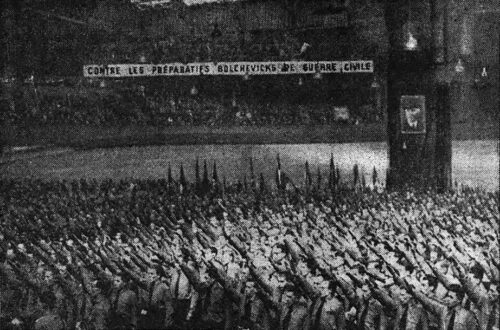
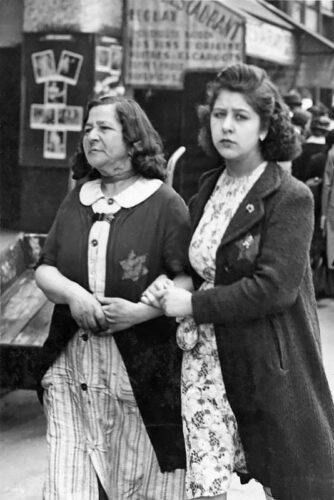
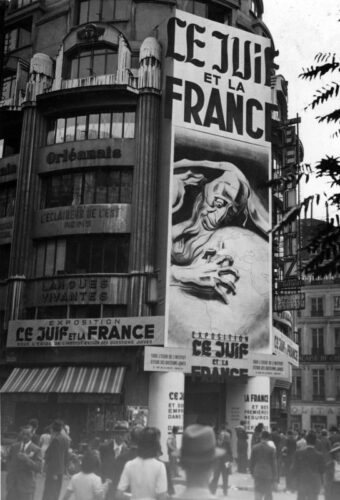
After four long years the dice for the liberation of Paris were cast. On 6 June 1944, better known as D-Day, the Allies managed to set a foothold on the northern coast of France. Even before the breakdown of the German lines, the Nazis and their collaborators were faced with a mounting wave of insubordination. With his vision of a thousand year Reich tumbling down, Hitler’s initial resolution for Paris had festered into a vengeful rage. Paris had to become an example, a horrid reminder that it was better for anyone or anything being in Hitler’s hands, the alternative to not stand at all. The orders to the German commander General Dietrich von Choltitz were clear. Before leaving, Paris should be completely destroyed. When the tracks laden with explosives started to cross the city’s streets, it seemed the fate of Paris was sealed. According to Choltitz’s memoir, Hitler’s orders to destroy Paris were defied by him at the eleventh hour because he loved the city and had decided that the man giving the orders had probably gone insane. The Free French 2nd Armored Division and the US 4th Infantry Division entered Paris on the night of August 24, 1944. On 25 August Cholitz signed the German surrender at the Hôtel Meurice. In that same day Charles de Gaulle, President of the Provisional Government of the French Republic, made his historic speech to the crowd from the Hôtel de Ville. Paris was free.
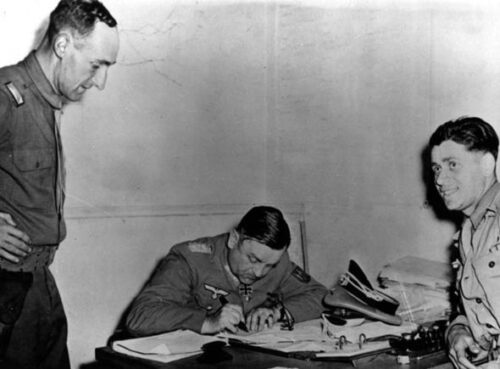

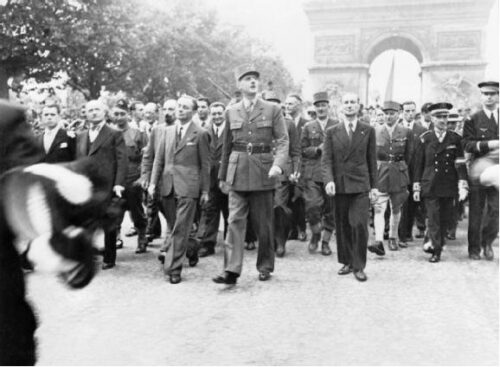
At first the city seemed to live just for revenge. Thousands of collaborators were arrested, hundreds were sentenced to death. Many of the women who had slept with German soldiers became a spectacle, tarred and feathered, their heads shaved were carried around for everyone to see. But life went on. On October 21, 1945, in the first elections in five years women were given the right to vote. In both national and municipal level the communists came out as the leading party, cashing in on their active role in the resistance.
The 40’s passed with the city and the country mending their wounds from the war. The fashion and automobile industries led the economic recovery that went hand in hand with constructions (apartment blocks for low income families) and the increase of population in the wider urban area of Paris that towards the end of the decade approached the number of 6 million people with an explosive upward trend.
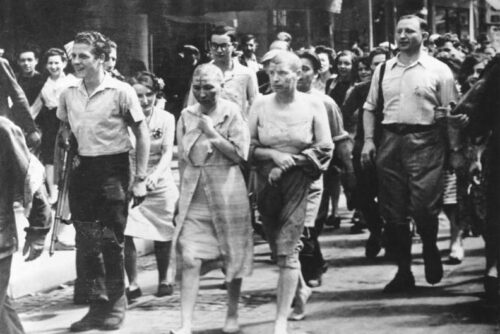
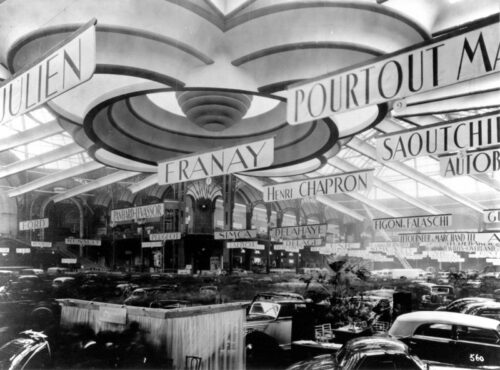
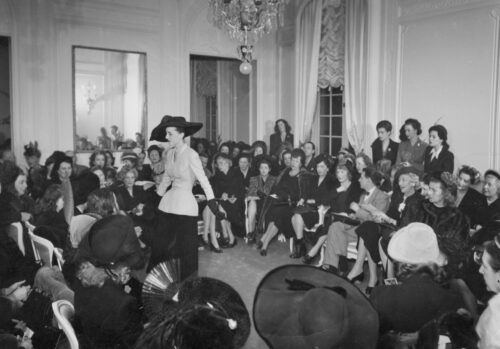
The 1950’s brought in Paris an influx of foreign immigrants from African countries, mostly former colonies and protectorates like Tunisia and Algeria with the latter staging an armed revolution for its independence. There were repeated demonstrations by Algerians and communists who had lost the government but not their impact in Parisian society. In the end of course it would be the great cost in French lives that would bring an end to the Fourth Republic (1946-1958) and the rise of Charles de Gaulle as president of the Fifth Republic (France’s current republican system of government, established in December of 1958).
With de Gaulle things improved for both France and Paris. The rapid economic growth brought by science, industrialization and peace started to transform Paris where many areas of the center were turned into work-spaces and offices increasing the price of land and driving middle class Parisians into the suburbs. In most cases the character of the old buildings and the exterior elements were preserved while the interior was renovated. Important historic landmarks like the Notre Dame were renovated and saved by the accumulated pollution of their outer surface.
Not everything was progressing. The Algerian war still lingered on and the outlawed National Liberation Front of Algeria had brought its war of independence on to French soil. In 1961 Maurice Papon, a Nazi collaborator who had willingly played a key role in the deportation of more than 1,600 Jewish French citizens to concentration camps during the Second World War, was head of the Parisian police forces and imposed a curfew on all French-Algerians. Denouncing this as racist, the FLN called on its supporters to hold a peaceful protest. A quarter of French Algerians participated, with the support of many French citizens of European descent. What followed is known as the Paris massacre of 1961. Between 200 and 300 unarmed protesters not only French-Algerians but many people of Tunisian, Moroccan, Spanish and Italian origin were also beaten and murdered by armed policemen in an orgy of violence that haunts Paris to this day.
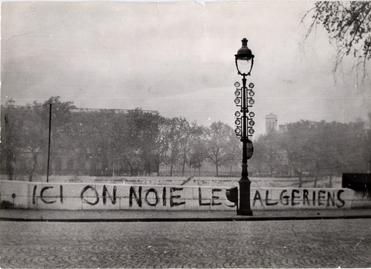
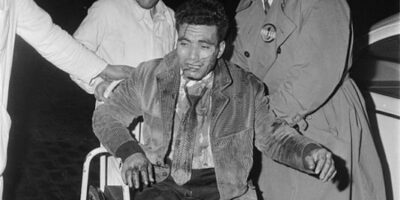
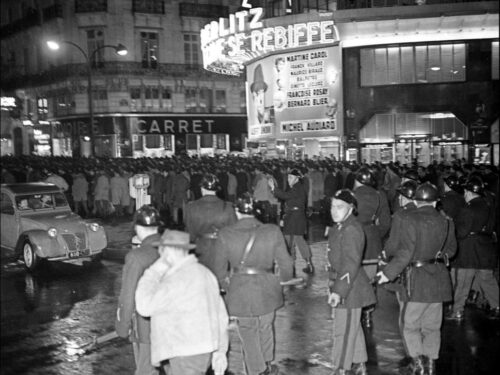
Just as the presidency of General de Gaulle was about to close its tenth year anniversary, the people, especially the ones belonging to the left (socialists/communists) had grown weary of his ageing autocratic figure. At the same time there was an explosive increase in the number of youth and students. It was the age of the baby boomers, that came after the end of WWII. The numbers said it all. During the years of de Gaulle’s presidency the student population had nearly trebled from 175.000 to more than 500.000. The ones under-20 had reached a staggering 33.8 per cent of the total population in 1968. Universities and educational establishments were not ready for that spike. Their facilities were inadequate and the teachers belonged to another more conservative reality. The youth culture of the age was anti-establishment, its gods were Sartre, Marx, Che Guevara and Bob Dylan. It was anti-imperialist, it loathed the War in Vietnam and consumerism culture, it was disillusioned with an oppressively hierarchical society.
In the Spring of 1968 some 12,000 students had found themselves studying at a suburb seven miles to the northwest (Nanterre campus) with a barely functional building. Their justified discontent flared up when they were denied their demand to circulate freely between the residences of males and female students, according to an outdated rule that was still in effect. After the arrest of several students in a demonstration against Vietnam war in Paris, some 150 students led by Daniel Cohn-Bendit occupied the administrative buildings of the Nanterre campus. When the police came the students released a statement of their wishes and left without any trouble. In early May another anti-imperialist protest was organized. Fearing a further escalation the dean shut down the campus. The students decided to take their protest to the Sorbonne, in the heart of Paris’s Latin Quarter. Barricades, Molotov, violent crashes with armed police, massive student marches and general strikes, burned cars, flying cobblestones, tear gases, clubbing and arrests brought De Gaulle, his government and the country’s economy to their knees in what evolved into the biggest uprising of the 20th century in the west. It would serve as a historical point of reference for every social unrest that would follow in the future.
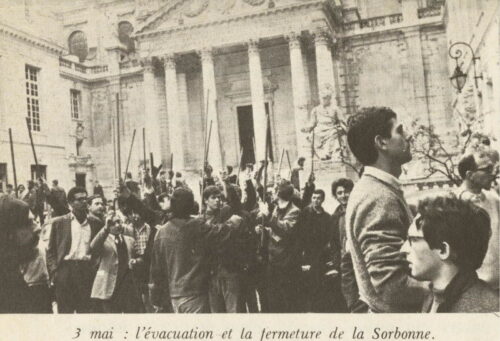
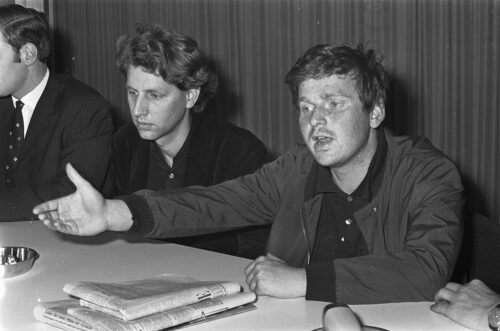
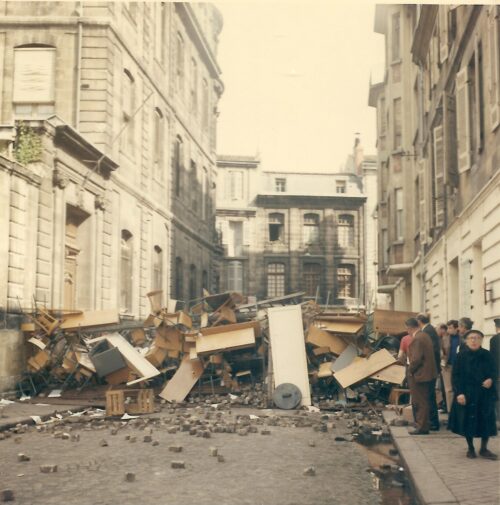
After 1969 it was the turn of Georges Pompidou to reshape Paris. Pompidou was Prime Minister from 1962 to 1968 but after the crisis of 1968 he succeeded De Gaulle as president of the French republic. His main efforts were centered on the modernization of the capital and the development of new highways and metro stations for the alleviation of the horrible traffic congestion that plagued Paris since the 1950’s. His main legacy would be the Centre Beaubourg better known as Centre Pompidou (renamed after his death in 1974). The president’s vision for a multidisciplinary cultural center of an entirely new type that would unite a new public library, a museum of modern art and an institute of musical research started taking shape in the early 1970’s. Today Centre Pompidou among other things is considered an emblematic 20th-century building of Europe.
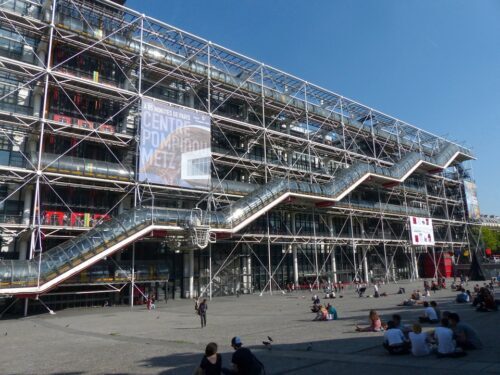

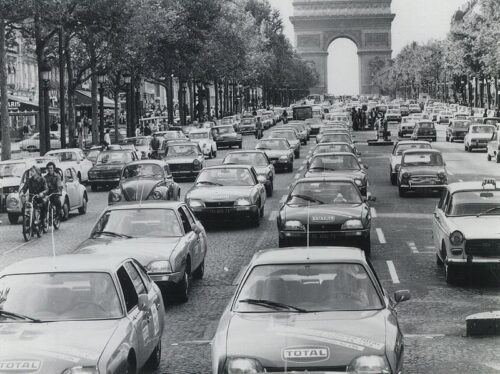
What mostly changed during the last years of the 1960’s up to the late 70’s was the location of several industries. After the right incentives given to them by the state many of them decided to leave the city for the suburbs or nearby cities like Rouen and Reims. Decentralization was a priority for both Pompidou and his successor Giscard d’Estaing. The latter was a modern centrist politician who embraced many of the values of the just established environmental movement and implemented policies for the increase of green spaces and pedestrian zones, the preservation of old buildings and the downsizing of new ones. His most outstanding contribution to the city was the transformation of the late 19th century Beaux-Arts railway station of Gare d’Orsay into a museum for 19th and early 20th century art. The Musée d’Orsay is today the museum with the largest impressionist and post-impressionist collection in the world.

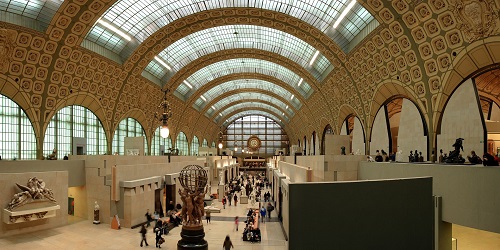
In the years that followed there were several new additions to the cityscape of Paris during the terms of President François Mitterrand (1981-1995) and Jacques Chirac (1995-2000), most notable of which being the Louvre Pyramid (1989), the Opera Bastille (1989) and the Musée du quai Branly (2006). There were also many parks inaugurated like Parc André Citroen and Parc de Bercy in the periphery of the city that lacked open green spaces.
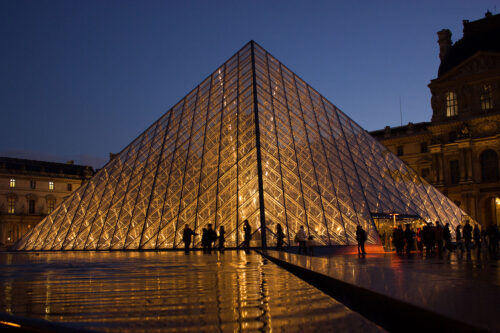
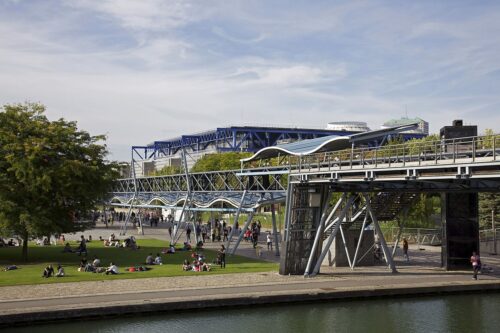
Today Paris is a bustling metropolis of more than 2.2 million people (wider region is home to more than 10 million people). About 20 per cent of people living in the city of Paris are immigrants. About 10 to 15% of the ones living in its metro area are Muslim, a percentage that is expected to increase considerably in the following years according to current trends. It is also the city with the largest Jewish population outside Israel and the United States (a little less than 300.000). According to the numbers Paris is the world champion of tourist arrivals with 2017 being a record year, the total number of visitors to its greater region, all accommodation combined, exceeding a record of 40 million tourists. Each year the tourist industry of the city brings a staggering 8.5 billion Euro to the national economy when at same time the local council earn more or less 30 million Euro, from the tourist tax alone.
The region of Paris alone accounts for more than 30 percent of the national GDP. Besides being one of the wealthiest regions in Europe it is also the most expensive in the continent and 2nd most expensive in the world behind Singapore. The historic center is classified as an UNESCO Heritage site, one that continues to mesmerize filmmakers from allover the world with its charm. Despite its world records in tourism Parisian economy does not depend solely in the tourist industry. It continues to be the home-base of the top ten French conglomerates like AXA, Total, BNP Paribas, Carrefour and Crédit Agricole. The majority of jobs belong to the service’s sector with the unemployment rate in 2018 being a little over 7%. The country’s gap between rich and poor is mostly visible in Paris through the distinction between its eastern and western part, the poorest being the eastern part of the city, a division coming from the time the Latin Quarter (eastern part) was just a scholar, a university, clerical and bohemian region of the city. This division still correlates in the outcome of the elections for example, with the west voting for center-right candidates and the east voting for socialists.
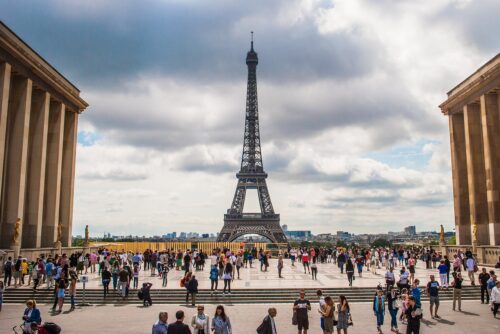
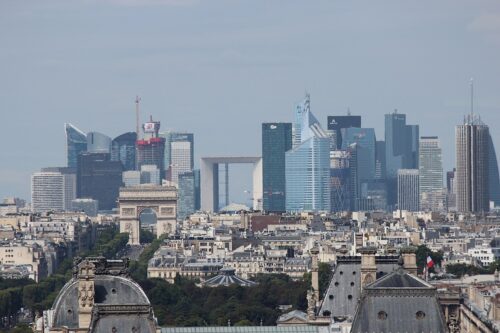

Adding further to the city’s stature are two other pillars of its economy, haute cuisine and haute couture. Fine dining and Paris have been close friends since the Belle Epoque. There are more than 9.000 restaurants based in Paris. Almost 6000 of them offer a spectrum of choices that fall into the extensive and world famous French cuisine. Out of the 27 highest ranking Michelin awarded restaurants in France, ten of them are located in Paris.
In the same time Paris is the fashion capital of the world, home to the most famous designers and largest fashion houses in the world like Hermès, Dior, Yves Saint Laurent, Chanel, , Louis Vuitton, Jean Paul Gaultier, Givenchy, and Pierre Cardin. Paris Fashion Week, held twice a year (winter/summer) is the biggest fashion show on earth. In 2017 the two weeks of the event produced a total income of more than 120 million euros in sum.
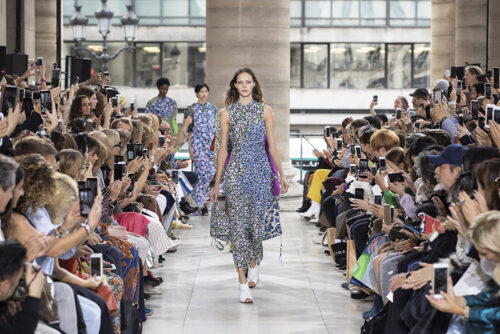
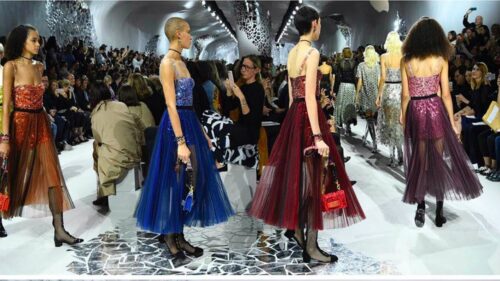
Overall Paris is still today what it always was. A great allure for anyone who hasn’t visited and a persistent siren calling for a return for anyone who has. The city of light seems to have a charm that defies the barriers of time. Judging from the national diversity of its visitors one could also say that it also defies the barriers of space. Hence its place up on the pedestal of eternal cities along with Rome. In Thomas Jefferson‘s words “A walk about Paris will provide lessons in history, beauty, and in the point of Life.” or according to Audrey Hepburn‘s words “Paris is always a good idea”.
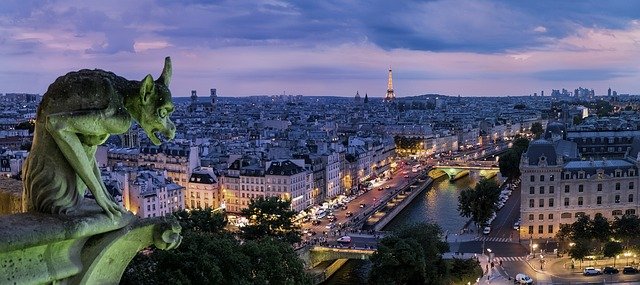
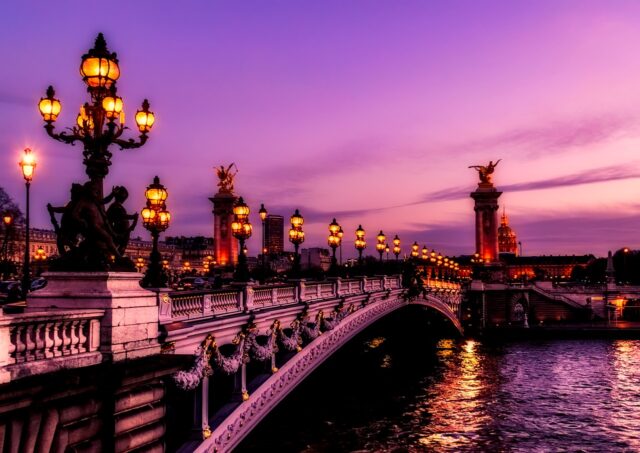
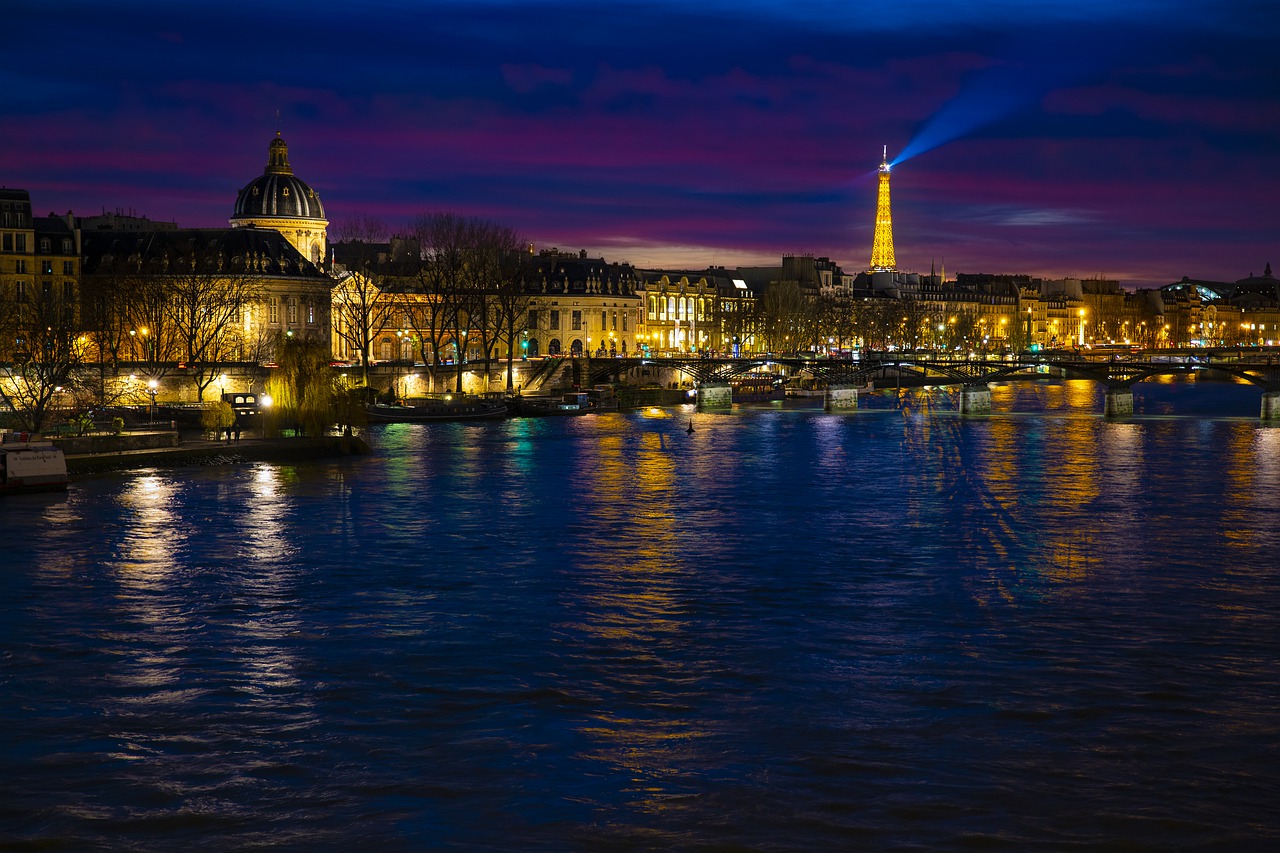
The end.

